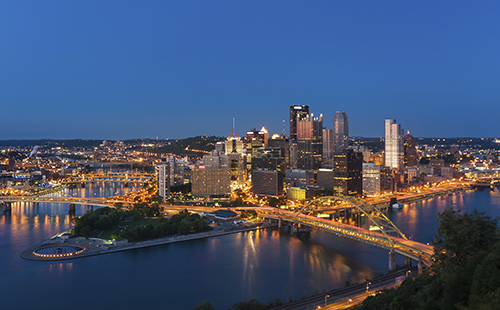Earth Hour
‘De-Lightful’ Event Kicks Off Astronomical Year
by Bruce Gerson
More than 60 buildings in downtown Pittsburgh are expected to go dark for Earth Hour, 8:30 - 9:30 p.m., Saturday, March 28.
Carnegie Mellon and Pittsburgh will kick off their International Year of Light celebration in the dark.
“De-Light Pittsburgh,” the city’s 2015 Earth Hour project, is one of many celebrations planned worldwide. From 8:30 – 9:30 p.m., Saturday, March 28, Pittsburgh will join cities around the globe, from Sydney to Paris to New York, in turning off lights to raise awareness for the environment and sustainability.
Around the world, lights will be turned off at iconic structures, such as the Eiffel Tower and Brooklyn Bridge. On campus, exterior lights will go dark on the Pausch Bridge, Hamerschlag Tower, Mellon Institute, Hunt Library, Doherty Hall, the East Campus Garage and Walking to the Sky.
In Pittsburgh, the event also aims to raise consciousness of light pollution and will serve as a launching point for stargazing, astronomy outreach events and activities throughout the year.
Diane Turnshek, a special faculty member in the Physics Department who has taught astronomy during the summers at CMU, Pitt and other local universities, is spearheading the effort at CMU. She said Earth Hour is a time to get people’s attention and to make them aware that there are many different things we can do to be good stewards of the planet.
She also hopes the event gets folks looking at the stars.
“You can see much more in the dark. Many observatories have had to close down because they were built too close to city lights,” she said.
The idea for an astronomical take on Earth Hour originated with Turnshek, who was a lead author of “The Astronomical Footprint,” a grant proposal submitted to the Heinz Endowments that also included the “Our Pittsburgh Constellation” project.
Our Pittsburgh Constellation is a Google map of all things astronomical in Pittsburgh.
“Astronomy enthusiasts can come to this one location to see where all the planetariums are, where the star parties are, where the classes are being taught, where the observatories are, where the museums are, where the telescopes are sold,” explained Turnshek.
The map will be put on the Earth Hour website, which will serve as a clearinghouse for all of the astronomical events happening this year. The locations on the map are identified with stars, leading to the Pittsburgh Constellation.
“We’re going to run a contest for artists on what they see in the stars on the city map. What is this Pittsburgh Constellation? What patterns in the stars do they see?”
Pirates, penguins, pierogies and other Pittsburgh items come to mind.
Other activities planned throughout the year include a citizen science project, called “Globe at Night,” in which citizens will go to a website to record their location, via longitude and latitude, and the brightness of the sky via a smartphone app.
Turnshek will be launching a series of art classes in which participants will be painting astronomical objects, such as comets, galaxies, star fields, planet scapes, things that would be more visible if we turned off the lights, she said.
“We’re shooting for astronomically correct art, so you can learn a little astronomy while creating art. That way we’ll teach them an appreciation of the sky. Our goal is to use art to help create social change,” she said.
The art will be displayed at Assemble, an art gallery in Garfield.
In addition to Turnshek, Earth Hour organizers at CMU include Don Carter, director of the Remaking Cities Institute, Don Coffelt, associate vice president and director of Facilities Management Services, University Engineer Marty Altschul, the Astronomy Club and Sustainable Earth.
Representing Pittsburgh are Aftyn Giles, sustainability coordinator in the Office of the Mayor; Anna Siefken of the Green Building Alliance; and Susan Rademacher of the Pittsburgh Parks Conservancy.
